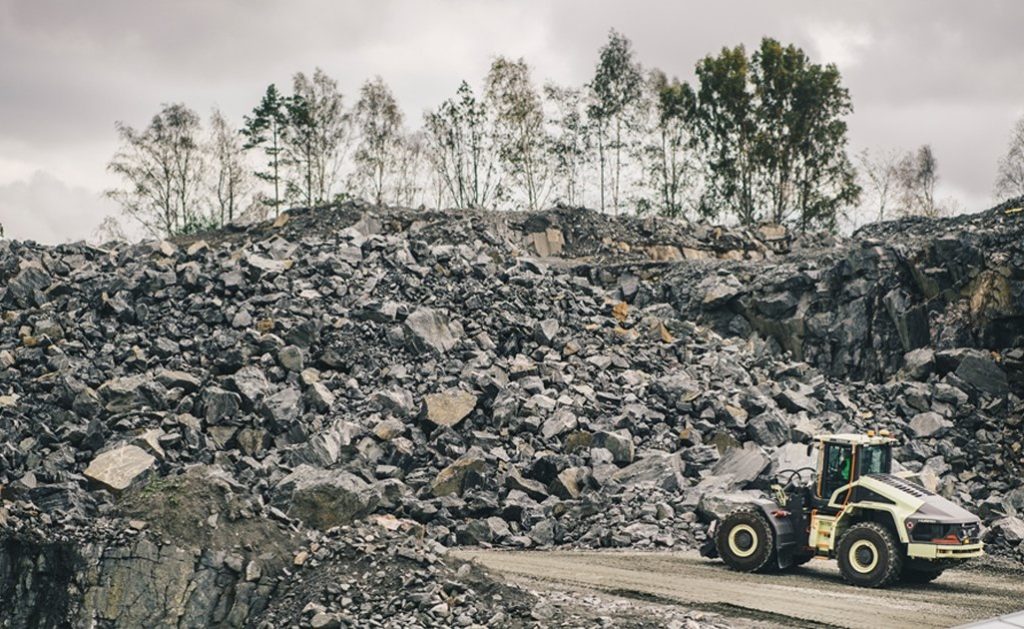Volvo Construction Equipment has started a 10-week trial of its ‘Electric Site’ concept at Skanska’s Vikan Kross operation, near Gothenburg, Sweden, as the two companies look to create the world’s first emission-free quarry.
The project, which incorporates electric and autonomous Volvo machines, will run in a real production environment aiming to achieve the same output as Skanska’s usual equipment, and is expected to deliver an anticipated 95% reduction in carbon emissions and 25% reduction in total cost of operations during the 10 weeks.
Drawing on the electromobility and automation expertise of the Volvo Group, the research project, dubbed Electric Site, aims to electrify each transport stage in a quarry – from excavation to primary crushing, and transport to secondary crushing – with only a negligible amount of diesel power being used.
Gunnar Hagman, CEO of Skanska Sweden, said: “This is the first time that anything like this has been attempted in the quarrying industry and, if successful, Electric Site could serve as a blueprint for transforming the efficiency, safety and environmental impact of quarries around the world.”
Its success will no doubt have ramifications for the mining industry, too.
Melker Jernberg, president of Volvo CE, said: “We have had to completely rethink the way we work and how we look upon machine efficiency – pushing the boundaries of our competence. The total site solution we developed together with our customer Skanska is not a commercial solution for sale today, and we will evaluate the outcome of the tests, but we have learnt so much already, elements of which will be fed into our future product development.”
The project has involved developing new concept machines, work methods and site management systems which, together, form a complete site solution. New technology encompasses machine and fleet control systems and logistic solutions for electric machines in quarries.
Three rigid haulers, for example, have been replaced by eight smaller prototype HX2 autonomous, battery-electric load carriers to transport the material from the primary mobile crusher up to the secondary static crusher.
This protoype has advanced significantly since the HX1 was first shown to customers and members of the international press at the Volvo Exploration Forum in September 2016, according to Uwe Müller, chief project manager for Electric Site at Volvo CE.
“The HX1 was our proof of concept,” he said. “Once we knew it was feasible, we updated the design requirements for the HX2 to incorporate shared technologies and components from the Volvo Group, such as electric motors, batteries and power electronics. Integrating a completely new drivetrain was crucial to take full advantage of the groundbreaking electromobility developments that are happening inside the Volvo Group.”
Another new feature is the addition of a vision system, which allows the machine to detect humans and obstacles in its vicinity, he added.
The primary crusher on the Skanska site is loaded by the 70 t dual-powered, cable-connected EX1 excavator prototype, which had not previously been seen by customers and press. The base machine for the EX1 is a Volvo EC750 model upgraded to incorporate an electric motor in addition to diesel engine.
“To fit the new components in the machine without increasing its size required a significant amount of repackaging work,” Müller said. “However, in terms of the operator interface and controls, nothing has changed – it’s operated in exactly the same way as a conventional Volvo excavator. If the cable is connected, the machine will automatically start in electric mode. If it’s not, it will start in diesel mode.”
Because the machine will be relatively static – only moving a few meters once or twice a day as the excavator works its way through the blasted rock – it is ideally suited as a fully electric machine on a cable, he added.
The stockpiles of material on site are organised by the LX1, Volvo CE’s prototype electric hybrid wheel loader. The machine can deliver up to a 50% improvement in fuel efficiency, as well as significant reductions in emissions and noise pollution compared to conventional counterparts.
The LX1 is a ‘series hybrid’ incorporating a driveline that consists of electric drive motors mounted at the wheels, electric-driven hydraulics, an energy storage system, a significantly smaller diesel engine and new machine architecture, including a new design of the lifting unit.
“It is this combination that enables the substantial gain in fuel efficiency,” Volvo CE says.
The prototype – which has 98% new parts and a fundamentally new machine design – can do the work of a wheel loader that is one size larger, according to the company.
Volvo CE teamed up with its customer Skanska Sweden, the Swedish Energy Agency and two Swedish universities – Linköping University and Mälardalen University – in October 2015 to collaborate on the SEK203 million ($22 million) Electric Site project.
Volvo CE is coordinating the project and is in charge of developing the machines and systems. Skanska Sweden is providing logistical solutions, application relevance and job site knowledge. The Swedish Energy Agency is helping to fund the project and the universities are carrying out research. Two PhD students are looking at battery ageing and energy management for electric vehicles, as well as functional safety.











